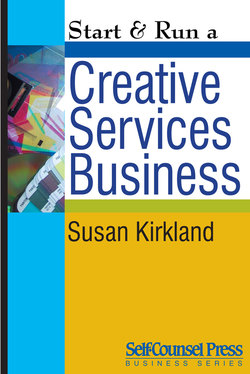Читать книгу Start & Run a Creative Services Business - Susan Kirkland - Страница 38
На сайте Литреса книга снята с продажи.
2. Welcome Variety and Challenge the Competition
ОглавлениеNow that you know what you can do, what do you enjoy? Remember all those times when the good jobs went to your superiors and you got the leftovers? Freelancing lets you pick and choose the type of assignment you want in good times. In bad times, when the pickings are slim, you’ll be surprised how much you enjoy putting together a car parts catalog. There’s no joy in not being able to make the mortgage payment, but it’s easy to enjoy thinking of ways to spend your profit while you move little pieces of line art to match the right copy block.
Bread-and-butter work is not exciting or glamorous — it doesn’t give you an opportunity to try out all those cool effects in Photoshop. When the posh stuff with the unlimited budget that makes a splashy portfolio piece comes along, make the most of it. Keep in mind that every job that crosses your desktop won’t be a portfolio piece. Don’t stick up your nose at drudge work, because the money spends the same, and as a freelancer, the object is to make money. This is only one of the ways things have changed since you became self-employed.
We would all like to spend our time designing beautiful things, but remember the fishbowl? The general rule is the big fish go after the big jobs. You will find yourself competing with some pretty big fish for the better work and, in hard times, even for small contracts. (I discuss how to protect your business and maintain control of jobs in Chapter 4.) Don’t be intimidated if you find yourself competing against a big studio. You may know their reputation, but a reputation may be the result of something completely different than raw talent and ability, as the following story illustrates.
One designer I met while freelancing worked at the number one design studio in a major metropolitan area. This studio was considered primo, and everybody wanted to work in their 40th-floor atrium office uptown. When I met this designer to show him my portfolio and update him on my recent projects, he told me he really admired the originality of my work and my great sense of aesthetics. A little incredulous, I countered with, “Well, your work is pretty good, too.” “Really it isn’t,” he said.
He opened the bottom drawer of his filing cabinet and showed me a collection of other people’s brochures he had stashed over the years, all neatly filed and labeled according to type and industry. He told me he kept everything attractive he came across in case he needed something to copy. Here he was, occupying the top design spot in the city and he didn’t have an original thought in his head. What he had was a potpourri of all the best design work in the market to pick and choose from at will. As I came to know from working with him, when he started a new project, he would pull someone else’s design work from his reference file and reproduce it right down to the font, paper stock, and color scheme.
The moral of this story is that you should not be intimidated by the big names who market in your area. Fight a good fight when you meet the competition. I can’t say it enough: The world is your oyster when your work is good. When you feel intimidated, remember there are plenty of pseudo designers and plagiarizing writers in the fishbowl with you who are not eager to identify themselves.
